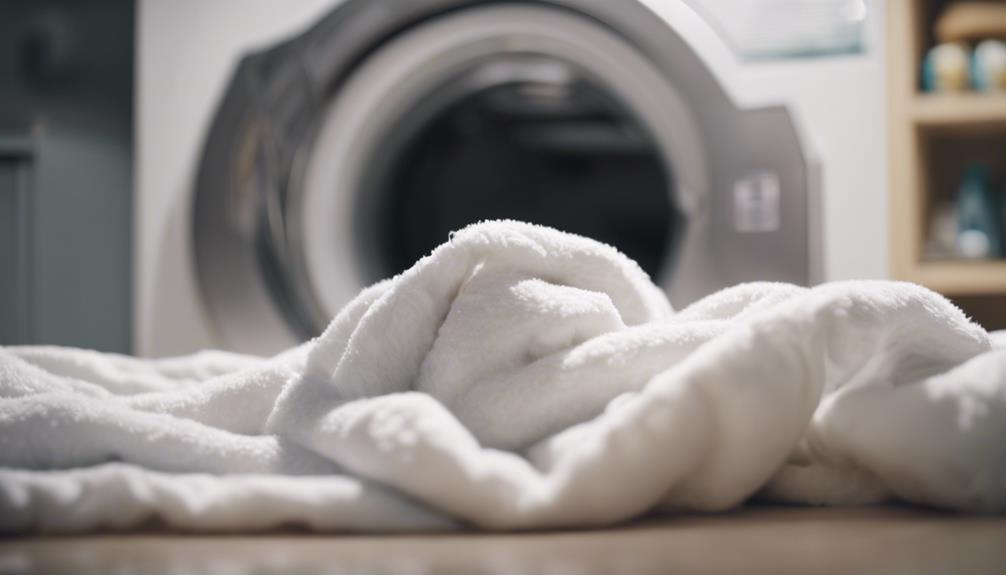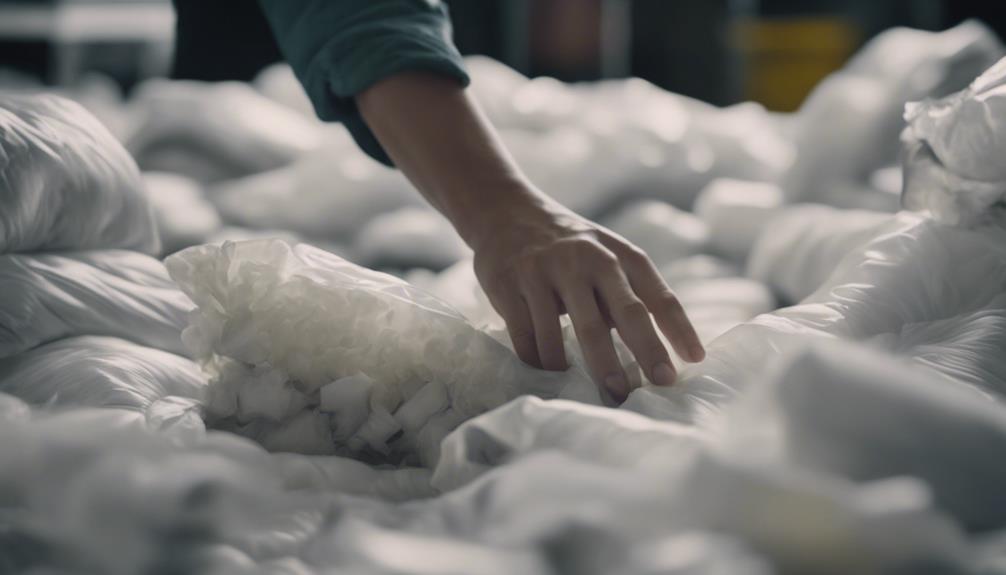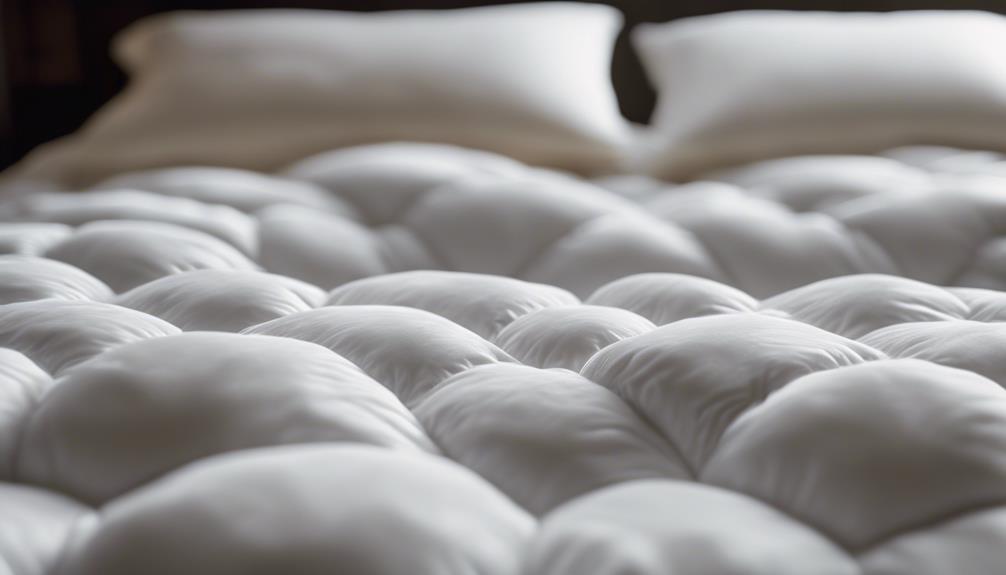When should you introduce a comforter to your baby? Comforters are typically introduced between 9-12 months when babies start seeking a sense of security. Safety guidelines suggest avoiding unsupervised soft toys until 12 months and choosing age-appropriate comforters. By 18 months, babies usually form attachments to their comforters. Ensure safe sleep practices by following recommendations from trusted sources like Red Nose. Remember, early introduction of a comforter can aid in establishing positive sleep associations and assist with nighttime soothing. Pay attention to signs of readiness like interest in soft textures and seek out security items for a smooth handover.
Key Takeaways
- Start introducing a comforter between 9-12 months for security and comfort.
- Safety guidelines suggest introducing a comforter at 7 months, avoiding unsupervised soft toys until 12 months.
- Attachment to a comforter typically forms at 18 months or later.
- Choose age-appropriate comforters and follow safety guidelines for comfortable use.
- Prioritize safe sleep practices and supervise the sleep environment when introducing a comforter.
Ideal Age for Introducing a Comforter
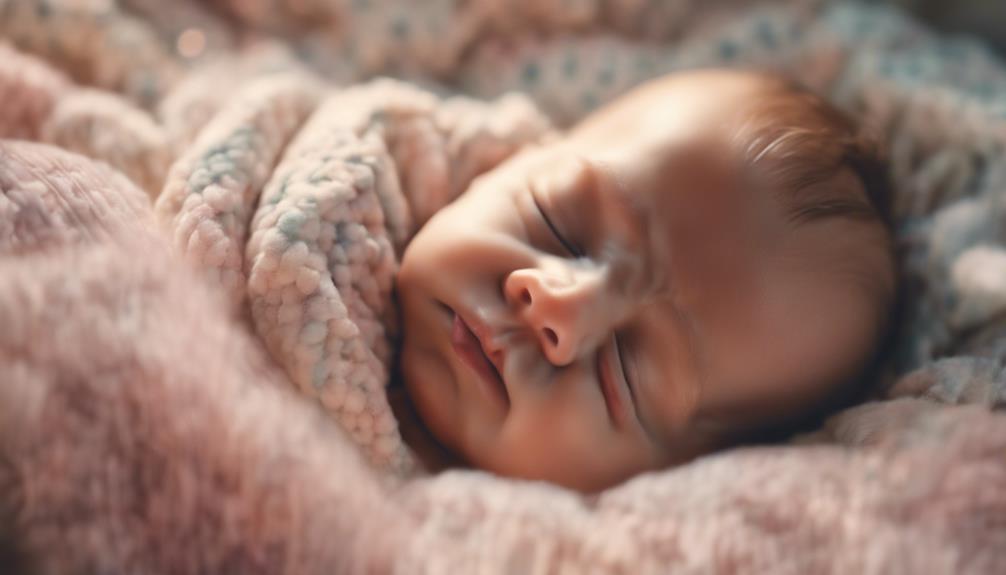
When deciding on the ideal age to introduce a comforter, it's crucial to start between 9-12 months to encourage attachment. At this stage, babies are developing a sense of security and comfort, making it a suitable time to introduce a soft object that can provide them with familiarity and reassurance. Starting between 9-12 months allows the baby to form a bond with the comforter, which can aid in soothing them during times of distress or separation.
Introducing the comforter at this age also aligns well with safe sleep guidelines that advise against having toys in the cot until the baby is at least 6 months old. By waiting until the baby is older, you can reduce the risk of any potential hazards while still providing them with the benefits of a comforting object.
Safety Guidelines for Comforter Use
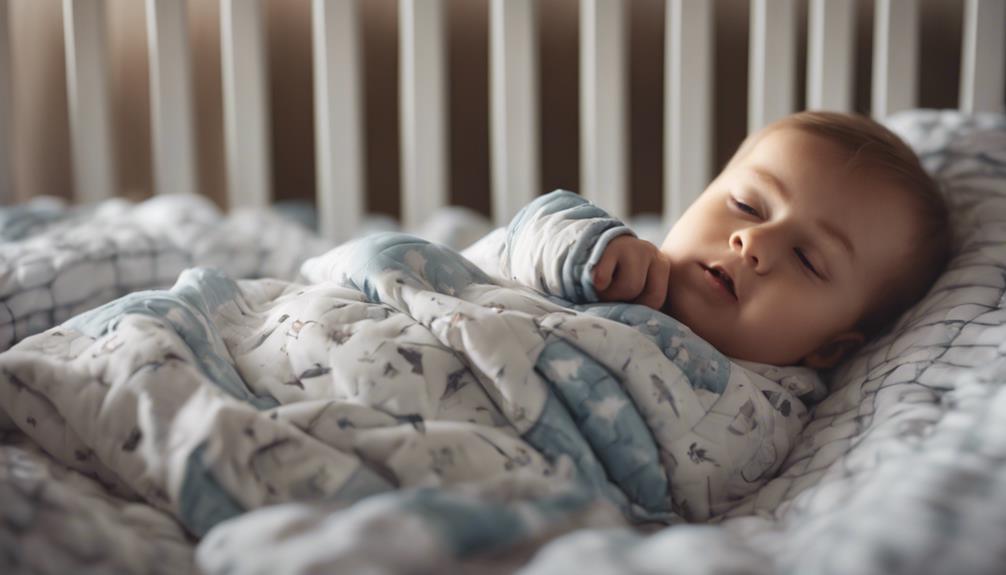
Safety is paramount when considering the use of comforters for infants. To guarantee the comforter is safe for babies, it's important to follow specific guidelines:
- Introduce a comforter at the right age: It's safe to leave a comforter unattended in the cot from 7 months of age.
- Avoid unsupervised soft toys: The Australian Competition and Consumer Commission (ACCC) advises against unsupervised soft toys in cots until 12 months.
- Wait for attachment: Attachment to soft toys typically occurs around 18 months or later.
- Choose age-appropriate comforters: Use age-appropriate and safe sleep comforters to reduce risks.
- Follow recommended guidelines: Red Nose recommends adhering to safe guidelines for the use of comforters in babies.
Benefits of Using a Comforter
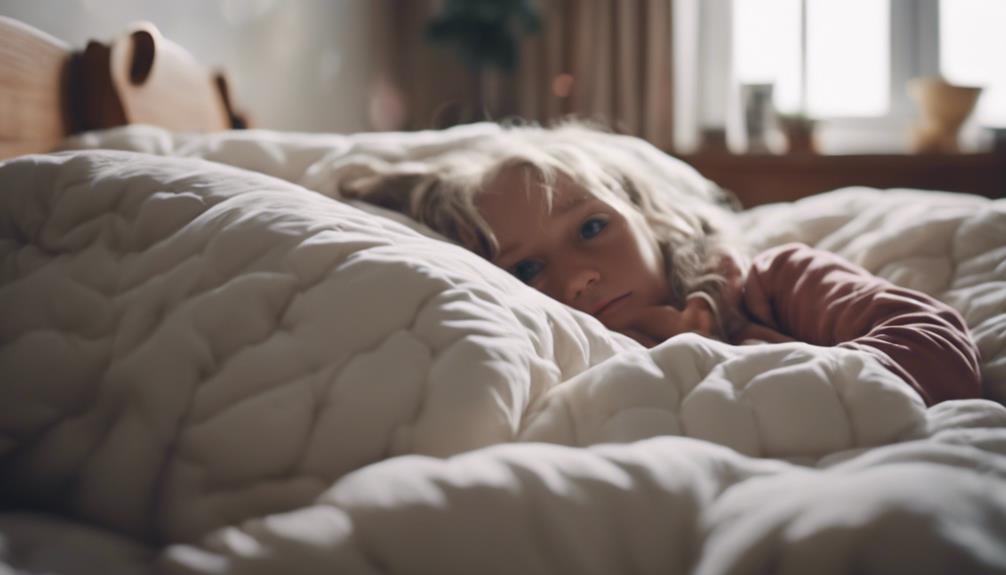
After ensuring the safety guidelines are met, exploring the benefits of using a comforter for infants reveals how these soft companions provide a sense of security and comfort during various moments. Babies often form attachments to these comforting objects, which can help them soothe themselves to sleep and navigate through different stages, such as bedtime routines, developmental milestones, or changes in their environment.
| Benefits of Using a Comforter | |
|---|---|
| 1. Security and Comfort | Comforters offer babies a sense of security and comfort, especially during bedtime or stressful situations. |
| 2. Self-Soothing | These comforting objects assist babies in self-soothing, reducing stress during events like immunizations or travel. |
| 3. Positive Sleep Association | Introducing comforters early on can help establish a positive sleep association for babies. |
| 4. Nighttime Assistance | Comforters aid in soothing babies to sleep and provide support during night wakings. |
Comforters made of breathable and washable fabric are ideal for babies, as they can be easily cleaned and maintained for regular use. Their role as a comforting object can greatly benefit babies in their sleep routines and overall well-being.
Comforter Vs. Other Sleep Aids
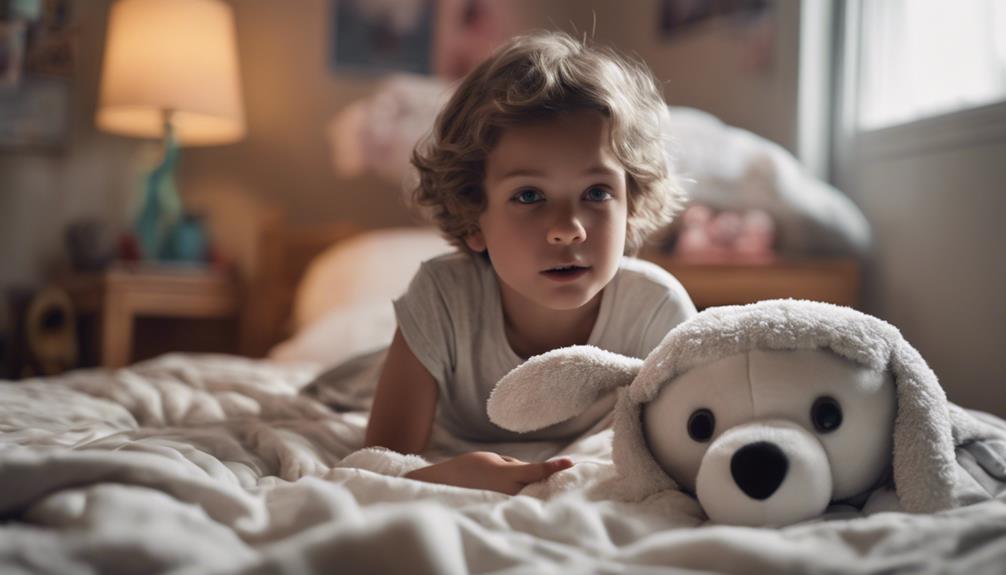
Comparing comforters to other sleep aids reveals the unique benefits they offer in providing infants with a sense of security and comfort during sleep. Unlike other sleep aids, comforters can help babies self-soothe and develop independence in managing their emotions. Comforters are often chosen by parents and recommended by sleep consultants for their effectiveness in soothing babies to sleep. While other sleep aids may serve specific functions, comforters offer a versatile and adaptable form of comfort for babies. The attachment formed with a comforter can be unique and personalized, fostering a strong sense of security and familiarity for the child.
- Comforters provide a sense of security and comfort for safe sleep.
- Comforters can introduce a soothing element that helps babies sleep independently.
- Comforters allow babies to self-soothe and manage their emotions.
- Comforters are versatile and adaptable compared to other sleep aids.
- Comforters help create a personalized attachment that promotes a strong sense of security.
Transitioning to Independent Sleeping
When moving towards independent sleeping with a comforter, it's important to take into account the sleep environment setup and a comforter selection guide.
These elements play a vital role in ensuring a smooth shift for your little one.
Sleep Environment Setup
Introducing a comforter to your baby between 7 and 10 months can help in establishing soothing sleep routines. As your baby moves to independent sleeping, creating a safe sleep environment is vital. Here are some essential tips for setting up the sleep environment:
- Place a safe sleep comforter in the crib to help your baby settle.
- Avoid bulky, 3D soft toys in the crib to follow safe sleep guidelines.
- Make sure the comforter is age-appropriate and free from small parts that could pose a choking hazard.
- Red Nose recommends using safe sleep comforters for babies to promote healthy sleep habits.
- Keep in mind that babies typically start forming attachments to comfort objects like blankets or cloths before 12 months.
Comforter Selection Guide
For a smooth shift to independent sleeping, selecting the right comforter is essential in aiding your baby's self-soothing and attachment process. When considering comforters for babies and toddlers, it's recommended to introduce them around 9-12 months of age. To avoid any risks, it's important to adhere to SIDS guidelines, which suggest refraining from placing toys in the crib until the baby is at least 6 months old.
Initially, using a muslin square for sleep association during feeding can help ease the move to a comforter later on. Specific comforter toys can be introduced when the baby moves to their own room, usually around 9 months old. Remember, each baby is unique, and some may not show interest in comforters until later, so observing their readiness cues is vital.
Establishing Positive Sleep Associations

During the important developmental stage between 7 and 10 months, incorporating a comforter can assist in establishing positive sleep associations for infants. This period is vital for forming healthy sleep habits that can last a lifetime.
Here are some key points to keep in mind when introducing a comforter to help foster positive sleep associations:
- Start Early: Introducing a comforter during this age range can help babies associate it with comfort and security during sleep.
- Follow Safe Sleep Guidelines: Make sure the comforter is age-appropriate and follows safe sleep recommendations to reduce the risk of Sudden Infant Death Syndrome (SIDS).
- Monitor Attachment: Babies typically start showing attachment to comfort objects before 12 months, which can be beneficial for self-soothing during sleep.
- Avoid Soft Toys: Red Nose advises against unsupervised soft toys in the cot for babies under 7 months to reduce the risk of suffocation.
- Be Patient: Attachment to soft toys usually occurs around 18 months or later, so be patient and allow your baby time to form a bond with their comforter.
Comforter Use During Nap Time
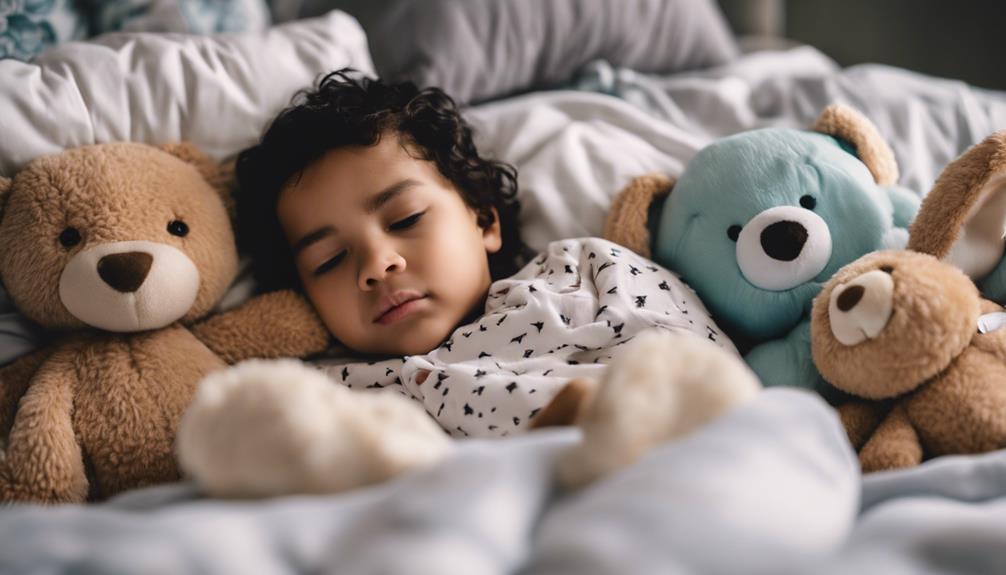
When considering comforter use during nap time, it's essential to follow specific guidelines for safety and comfort.
Babies around 7-10 months old can benefit from having a comforter in the crib during nap time.
Nap Time Comforter Guidelines
Introducing a comforter for nap time around 7-10 months old can help soothe babies and create a sense of security. When it comes to using a comforter during nap time, there are some guidelines to keep in mind:
- Make sure the comforter is age-appropriate and safe for sleep.
- Use the comforter consistently during nap time to establish a sleep ritual.
- Encourage babies to self-soothe with the comforter to aid in falling asleep independently.
- Follow safe sleep practices recommended by organizations like Red Nose.
- Incorporate the comforter into your baby's nap routine to help them feel secure and comfortable during sleep.
Benefits of Using Comforter
Using a comforter during nap time can greatly enhance a baby's sense of security and comfort. Comforters provide a source of familiarity and soothing for babies, helping them feel secure and relaxed during naps.
The presence of a comforter can aid in establishing a comforting nap time routine, as babies may develop an attachment to their comforter, making nap time more manageable. Introducing a comforter during nap time creates a positive association with sleep, promoting better rest.
Signs Your Baby Is Ready for a Comforter
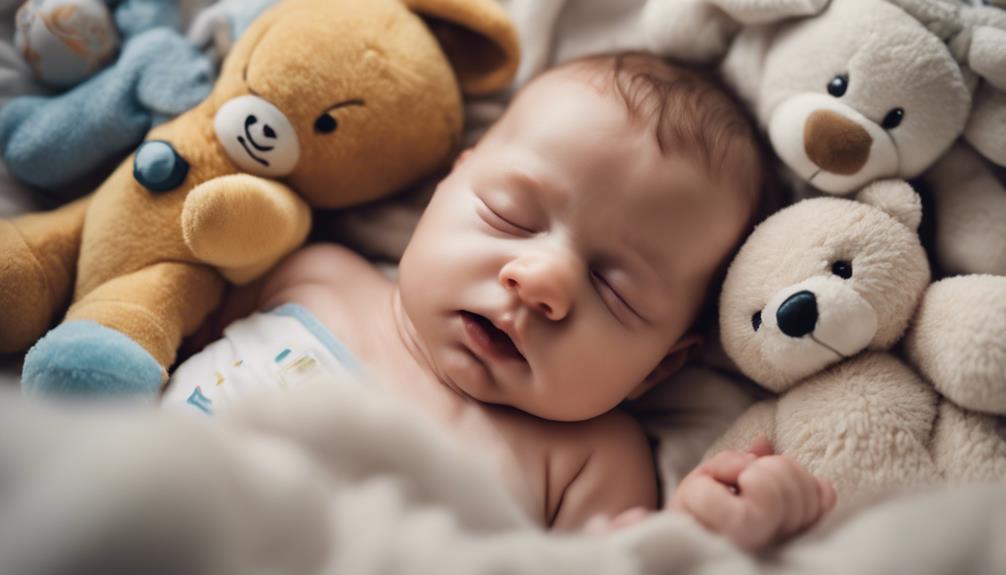
As parents, we can observe signs that indicate our baby is ready for a comforter around the age of 7 to 10 months. It's crucial to pay attention to these cues to introduce a comforter at the right time for our baby's emotional well-being.
Some signs that your baby is ready for a comforter include:
- Showing interest in soft textures and fabrics.
- Seeking out security items when feeling distressed.
- Exhibiting self-soothing behaviors like thumb-sucking or cuddling with blankets.
- Displaying separation anxiety when away from primary caregivers.
- Forming attachments to specific items, like a soft toy or a piece of cloth.
Tips for Introducing a Comforter
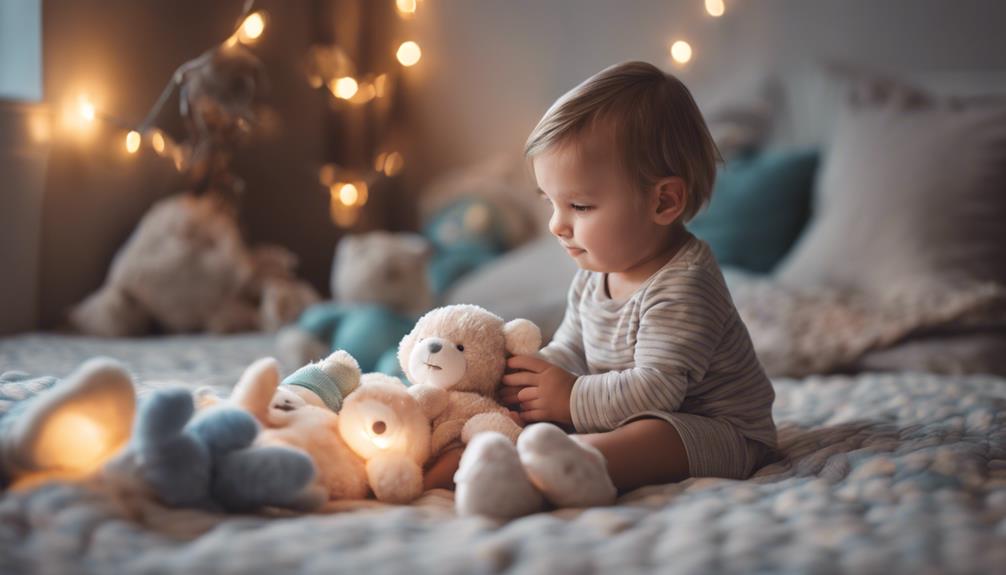
How can we smoothly incorporate a comforter into our baby's routine to promote feelings of security and comfort?
When introducing a comforter to your baby, it's essential to prioritize safe sleep practices. Remember to always place your baby on their back to sleep, ensure a supervised sleep environment, and avoid loose bedding or toys in the crib.
To start the introduction process, consider using a muslin square that your baby can associate with feeding. This can help create a positive connection before moving to a specific comforter toy. Typically, babies may show interest in comforters around 9-12 months of age or when they move to their own room. However, it's important to be attentive to your baby's individual preferences, as some may not engage with comforters until later.
Frequently Asked Questions
What Age Can a Child Have a Comforter?
Between 9-12 months is a common age range for introducing a comforter to your child. It's advisable to wait until your little one is around 6 months old before adding toys to the crib, following SIDS guidelines.
Many parents start introducing comforters around 9 months when their baby moves to their own room. While some babies may show interest earlier or later, starting between 9-12 months is a typical practice for introducing comforters.
Can I Give My 3 Month Old a Comforter?
We don't recommend giving a comforter to a 3-month-old baby due to safety concerns. Soft bedding like comforters in the crib can increase the risk of suffocation, entrapment, or SIDS.
It's best to wait until your baby is at least 7-10 months old before introducing a comforter. For safe sleep, babies under 6 months should sleep in a bare crib with just a fitted sheet.
Follow guidelines from organizations like Red Nose for your baby's sleep environment.
Can a 15 Month Old Sleep With a Comforter?
At 15 months, it's generally advisable for a child to sleep with a comforter. By this age, most children have formed attachments to comfort items.
To minimize risks, choose a safe and age-appropriate comforter. While entanglement risks are lower at this age, supervision is still recommended to guarantee safe sleep practices.
Remember to prioritize safety and comfort when introducing a comforter to a 15-month-old for peaceful sleep.
Why Are Comforters Good or Bad for Toddlers?
Comforters can be beneficial for toddlers by providing comfort and security, aiding in easing separation anxiety and promoting independent sleep. They can serve as a familiar signal for bedtime, helping toddlers feel safe and secure as they drift off to sleep.
However, it's important to follow safe sleep guidelines to prevent any risks, such as avoiding bulky or 3D soft toys in the cot for children under 12 months.
Can a Comforter Be Safe for a Baby to Use?
When it comes to choosing a baby comforter age recommendation is vital. A soft and lightweight comforter can be safe for a baby to use, as long as it is specifically designed for infants and meets safety standards. Always follow the manufacturer’s guidelines to ensure a safe sleeping environment for your little one.
Conclusion
To sum up, introducing a comforter to your child at around 6-12 months can help foster feelings of security and comfort during sleep. Keep in mind, safety guidelines should always be followed to guarantee a safe sleep environment.
As the saying goes, 'better safe than sorry.' By gradually introducing a comforter and establishing positive sleep associations, you can assist your child in moving towards independent sleeping and promote healthy sleep habits.

